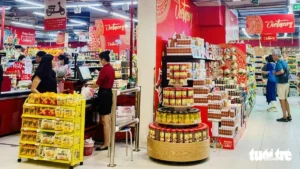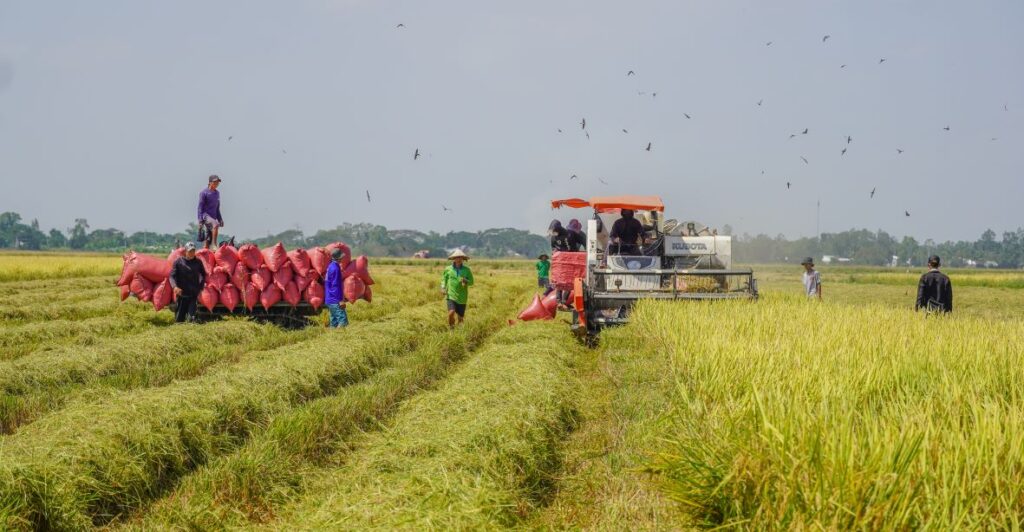In 2024, rice exports achieved remarkable results. However, in 2025, the context is no longer favorable, rice exports will face many pressures.
Pressure from many sides
In 2025, the rice production area is 7.0 million hectares, a decrease of 132 thousand hectares compared to 2024; the expected yield is 61.6 quintals/ha, an increase of 0.6 quintals/ha; the estimated output is about 43.143 million tons, a decrease of about 357 thousand tons compared to 2024.
Reporting to the Ministry of Finance on the supply, production, and price developments of agricultural products and agricultural materials in 2024 and 2025, the Ministry of Agriculture and Rural Development said that it is forecasted that the balance of commercial rice for export in 2025 will be mainly concentrated in the provinces of the Mekong Delta (MD); other regions will mainly serve domestic consumption. Estimated production in 2025 in the MD will reach 3.778 million hectares, with an average yield of 63.4 quintals/ha; estimated output will reach 23.965 million tons.
Commercial rice for export is estimated at 15.085 million tons, equivalent to 7.54 million tons of commercial rice for export, of which the amount of commercial rice for export in the first 6 months of the year is estimated at 4.50 million tons. The amount of commercial rice for export in the last 6 months of the year is estimated at 3.04 million tons.
According to the latest data from the Ministry of Agriculture and Rural Development (MARD), the estimated volume and value of rice exports in January 2025 reached 500 thousand tons and 308 million USD, up 1% in volume but down 10.4% in value compared to the same period in 2024. It is worth noting that since the beginning of the year, Vietnam’s rice export prices have dropped to the lowest in the world and have continued to decline sharply until now.
Regarding rice prices, information from the Vietnam Food Association (VFA) shows that 25% broken rice is at 371 USD/ton; 100% broken rice is at 313 USD/ton; Vietnam’s 5% broken rice export price is still at 397 USD/ton, the lowest since September 2022 and also the lowest price in the region. Accordingly, Thailand’s 5% broken rice is quoted at 426 USD/ton; Pakistan’s is 401 USD/ton; and India’s is at 413 USD/ton. Meanwhile, the Food and Agriculture Organization of the United Nations (FAO)’s total rice price index averaged 113.6 points in January, down about 4.7% compared to the previous month and down 20.4% compared to the same period last year. Indica rice prices recorded the sharpest monthly decline, falling 5.4% month-on-month to a 25-month low. Fragrant rice and glutinous rice prices fell 4% and 1.8%, respectively.
Speaking to reporters, agricultural expert Nguyen Chi Mai said that since the beginning of 2025, the downward trend in rice export prices has been causing many producers and businesses to worry. Currently, rice prices have fallen to their lowest level in the past 3 years and the average export price may fall below 600 USD/ton due to more abundant supply.
“Vietnamese rice is facing fierce competition from other rice exporting countries such as India, Thailand, Cambodia… These competitors are trying to increase food supply to the global market and this has put pressure on rice prices, causing rice prices to decrease. Meanwhile, import demand from major partners is forecast to decrease sharply. In general, looking at the road ahead, our country’s rice exports will face many ups and downs,” Ms. Mai shared.
In addition, a weakness that reduces the competitiveness of Vietnamese rice is the uneven quality of rice. Mr. Doan Quoc Tai – a rice trader in Soc Trang said that the scale of Vietnam’s rice production industry is still small, scattered and the small-scale production organization leads to uneven quality of rice, making it difficult to export.
In particular, according to economist Nguyen Tri Hieu, another difficulty for Vietnam’s rice exports in 2025 is protectionist policies. This policy tends to increase strongly and can significantly affect Vietnam’s rice exports. “When importing countries apply protectionist policies, the first thing they will do is increase import taxes or impose import quotas to protect domestic agriculture. This can reduce the demand for rice imports, leading to a decrease in our country’s export turnover of this item,” Hieu analyzed.
What should businesses do?
In response to this question, Ms. Mai said that, first of all, our country must improve the quality of rice, focus on producing high-quality rice, meeting the needs of import markets, including the most demanding markets such as the EU. The industry and localities need to focus on producing high-quality rice that is popular in the market, such as fragrant rice and specialty rice. At the same time, proactively research and grasp information about market demand and trends to adjust production and export plans accordingly.
“Vietnam needs to proactively diversify its markets and increase rice exports to new markets such as Europe, the US, Japan, the Middle East, West Asia, Africa… We should take advantage of free trade agreements to both enjoy tariff incentives and conquer and increase rice exports to new markets,” Ms. Mai further emphasized.
In addition, regarding the issue of dealing with protectionist policies, according to Mr. Hieu, diversifying export markets, improving the quality and added value of exported rice and taking advantage of opportunities from Free Trade Agreements (FTAs) are effective solutions. Vietnam can take advantage of protectionist policies to increase rice exports to other markets. For example, participating in FTAs such as EVFTA, UKVFTA, EAEU… can help Vietnam increase rice exports to new markets and expand market share in existing markets.
“Strengthening cooperation with importing countries and participating in international trade forums can also help Vietnam protect its interests and increase rice exports. On the other hand, enterprises in the rice industry should strengthen cooperation with foreign enterprises to learn from experience and transfer technology, and train skilled workers in the rice export industry to meet market demand,” Mr. Hieu recommended.
Regarding this issue, Minister of Industry and Trade Nguyen Hong Dien directed that, in the context of the fluctuating and unpredictable rice market, the domestic rice production industry must organize production well, ensure the quality of rice grains and product brands, maintain food security in all situations, maintain orders and maintain export markets. Relevant ministries and sectors promptly propose support measures for rice growers and rice producers and exporters so that they can focus on production and improve rice quality. From there, Vietnam will become one of the pioneering countries in the production of high-quality rice, creating even greater added value for Vietnamese rice.
















